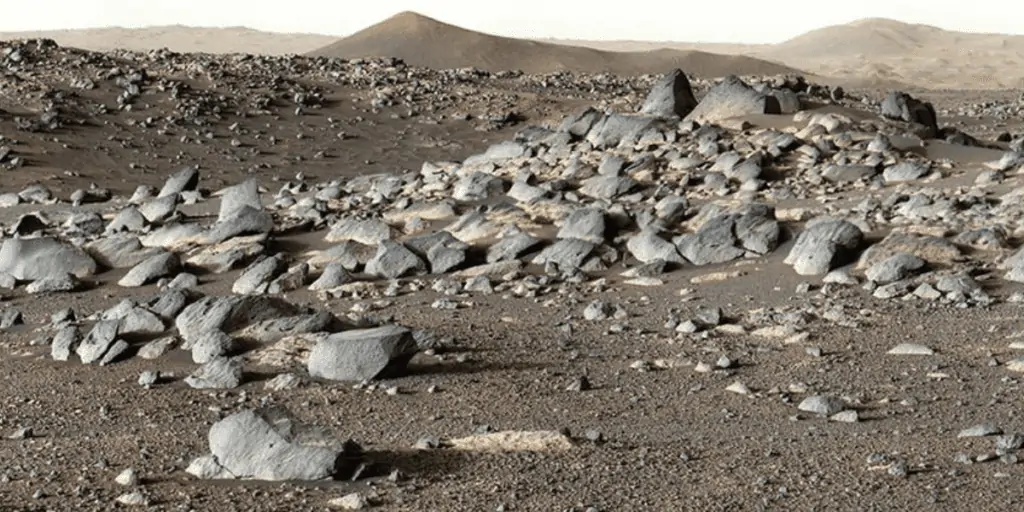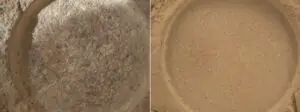The Perseverance rover of Mars detected hints of the presence of ancient life on Mars from the rock samples of Wildcat ridge of Jezero Crater.
Table of Contents
ToggleNASA’s Perseverance Mars rover, nicknamed Percy designed to explore the Jezero Crater on Mars is a car-sized rover. It carried nineteen cameras, seven primary payload instruments, and two microphones.

The key goals of the rover are astrobiology, i.e. to identify ancient Martian environments capable of supporting life, search for signs of ancient microbial life, collection of rock and soil samples, and test oxygen production from the Martian atmosphere and send back the samples to earth for intensive study.
Recently Perseverance Rover has detected its highest concentrations of organic molecules, which is a sign of the existence of ancient life on Mars, which increased eager of scientists to confirm the rock samples when they will be brought to earth.
The rover has collected four samples from an ancient river delta in Mars’s Jezero Crater since July 7, bringing the total count of scientifically compelling rock samples to 12.
Related: Best Five Star-Projectors: Bringing the Cosmos into Your Home
Thomas Zurbuchen, NASA’s associate administrator for science in Washington said that;
“We picked the Jezero Crater for Perseverance to explore because we thought it had the best chance of providing scientifically excellent samples – and now we know we sent the rover to the right location,”
“These first two science campaigns have yielded an amazing diversity of samples to bring back to Earth by the Mars Sample Return campaign.”
Jezero Crater
Jezero crater lies exactly on the border between the ancient highland region of Terra Sabaea, where rocks from 4.1–3.7 billion years ago can still be found, and the 3.9-billion-year-old Isidis impact basin.

The width of the Jezero crater is Twenty-eight miles (45 kilometers), and hosts a delta – an ancient fan-shaped feature that formed about 3.5 billion years ago at the convergence of a Martian River and a lake.
Perseverance is presently probing the delta’s sedimentary rocks, formed when patches of colorful sizes settled in the formerly-watery terrain.
During its first science campaign, the rover explored the crater’s floor finding igneous rock, which forms deep underground from magma or during volcanic activities at the surface.
Related: Meteor Shower and its incredible facts!
According to the Perseverance project scientist, Ken Farley of Caltech in Pasadena, California, due to the crystallization of magma (on the crater floor), the delta, with its diverse sedimentary rocks, contrasts beautifully with the igneous rocks.

The apposition helps in a clear understanding of the geologic history of Martian rocks formed after the crater and a diverse sample collection.
During the sample collection, Perseverance got a sandstone that comprises grains and rock fragments, which are created far from Jezero Crater, and a mudstone that includes fascinating organic compounds.
Mars’s Skinner Ridge and Wildcat Ridge and their mineral Composition
In the past few months, the rover has collected two pairs of cores, from two different types of sedimentary rocks called “Skinner Ridge” and “Wildcat Ridge”, both make up the edge of the delta of Jezero Crater.

The rocks of “Skinner Ridge” is made of fine-grained sandstone and this type of rock is seen in many places on Earth.
The cores of Skinner Ridge rock contained round grains of dark material; those were probably carried by the ancient river that once flowed into the Jezero Crater.
So, investigating those dark grains might reveal the history of a wide range of areas of Mars.
Recently the other pairs of cores collected from Wildcat Ridge lie just 20 meters away from Skinner Ridge. The color of the cores is lighter and more homogeneous than the cores of Skinner Ridge.
On Earth, the finer grains are found to be settled out in low-energy environments such as the bottom of pond, river and the settled materials preserves decaying organisms.
Must Read: Nanotechnology Products in Daily Life in 2022
Therefore, the finer grains in the rock bring hope for the finding of certain evidence of past life.
“Wildcat Ridge” is a rock about 1 meter (3 feet) wide found in the delta of Jezero Crater, expected to be formed billions of years ago as mud and sand settled in an evaporating saltwater lake.
The rover scraped some of the surfaces of Wild Ridge for the analysis of the area by the instrument called Scanning Habitable Environments with Raman & Luminescence for Organics & Chemicals (SHERLOC).
The SHERLOC uses cameras, a laser, and a spectrometer to search for signs of life and minerals of interest.
Interestingly, the results from the analysis detected a class of organic molecules, which are spatially correlated with those of sulfate minerals.
The Sulfate minerals found in layers of sedimentary rock can produce significant evidence about the aqueous environments in which they formed.
Related: James Webb Telescope Images with Details Discussion
Organic Matters and life on Wildcat Ridge of Mars
The organic matter detected from the Wildcat Ridge rock by the SHERLOC instrument comprises a wide variety of compounds composed of primarily carbon and hydrogen and oxygen atoms.
Other elements, such as nitrogen, phosphorus, and sulfur also found, and some of the molecules of these compounds are the building block of life called biomolecules.
Therefore, the finding of these biomolecules hints toward the potential biosignature and existence of past life on Mars.
Further, Perseverance project scientist, Ken Farley said that “In the distant past, the sand, mud, and salts that now make up the Wildcat Ridge sample were deposited under conditions where life could potentially have thrived”.
“The fact the organic matter was found in such a sedimentary rock – known for preserving fossils of ancient life here on Earth – is important.
Related: Space Pens or Pencils: How NASA Takes Notes in Space?
However, as capable as our instruments aboard Perseverance is, further conclusions regarding what is contained in the Wildcat Ridge sample will have to wait until it’s returned to Earth for in-depth study as part of the agency’s Mars Sample Return campaign.”
The results of the investigation are also indicating the presence of aromatic organic molecules, which plays a key role in life or biochemistry.
In this context, one of the astrobiologists of NASA, Sunanda Sharma, JPL Postdoctoral Fellow, NASA’s Jet Propulsion Laboratory, Pasadena, CA, said that “This is a treasure hunt for potential signs of life on another planet,”
“Organic matter is a clue and we’re getting stronger and stronger clues…I personally find these results so moving because it feels like we’re in the right place, with the right tools, at a very pivotal moment.”
There have been other enticing clues about the possibility of the presence of life on Mars before, including repeated detections of methane by NASA’s Curiosity Mars rover in 2013.
However, methane gas is a digestive by-product, produced by the microbes on Earth, and it can also be produced by geothermal reactions without the involvement of microorganisms.
Mars sample-return mission
NASA and European Space Agency plan to send other spacecraft to Jezero Crate to pick up the samples including the cores collected by the Perseverance rover and bring them back to Earth in the coming years.
The samples will be intensively analyzed by scientists with advanced hi-tech laboratories.
While the samples will be the first ever returned from Mars, these are expected to arrive no earlier than 2033.
“To undertake the challenge and the expense of a Mars sample-return mission, we need a great suite of rocks to bring back,” Laurie Leshin, Director of the Jet Propulsion Laboratory in Pasadena, California, said at a press briefing on 15 September.
“We are off to a great start.”
You May Also Read: Webb Telescope Revealed “Cosmic Cliff” and Star Formation















